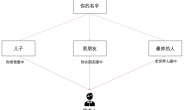一:SpringBoot简介
当前互联网后端开发中,JavaEE占据了主导地位。对JavaEE开发,首选框架是Spring框架。在传统的Spring开发中,需要使用大量的与业务无关的XML配置才能使Spring框架运行起来,这点备受许多开发者诟病。随着Spring4.x发布,Spring已经完全脱离XML,只使用注解就可以运行项目。为了进一步简化Spring应用的开发,SpringBoot诞生了。它是由Pivotal团队提供的全新框架,其设计目的是简化Spring应用的搭建及开发过程,并迎合时下流行的分布式微服务设计思想,越来越多企业在使用SpringBoot
1:设计初衷
SpringBoot为我们开发者提供了一种更快速、体验更好的开发方式,我们可以开箱即用,无需像写Spring那样配置各种XML文件,虽然Spring3.0时引入了基于java的配置,但是编写这些配置无疑是在浪费大量时间,其实SpringBoot还内置Tomcat
2:核心功能
一:独立的运行Spring SpringBoot 可以以jar包形式独立运行,运行一个SpringBoot项目只需要通过java -jar xx.jar来运行 二:内置Servlet容器 Spring Boot可以选择内嵌Tomcat、jetty或者Undertow,这样我们无须以war包形式部署项目 三:简化Maven配置 SpringBoot提供了一系列的start pom来简化Maven的依赖加载,例如,当你使用了spring-boot-starter-web 四:自动装配 SpringBoot会根据在类路径中的jar包,类、为jar包里面的类自动配置Bean,这样会极大地减少我们要使用的配置。
当然,SpringBoot只考虑大多数的开发场景,并不是所有的场景,若在实际开发中我们需要配置Bean,而SpringBoot
没有提供支持,则可以自定义自动配置 五:准生产的应用监控 SpringBoot提供基于http ssh telnet对运行时的项目进行监控 六:无代码生产和xml配置 SpringBoot不是借助与代码生成来实现的,而是通过条件注解来实现的,这是Spring4.x提供的新特性
Spring Boot只是Spring本身的扩展,使开发,测试和部署更加方便
3:本文开发环境需求
SpringBoot 2.4.1正式发行版,要求Java8并且兼容Java15;对应的Spring版本是5.3.2;而且要求Maven 3.3+ 但是最好使用3.5.4稳定版本,而Servlet容器的版本为Tomcat9.0(Servlet Version 4.0)、Jetty 9.4(Servlet Version 3.1)、Undertow 2.0(Servlet Version 4.0)
二:SpringBoot入门搭建
1:手动搭建案例
我们以一个简单的SpringBoot案例来突显出Spring的繁琐,我接下来将使用SpringBoot来实现一个简单的带Controller的案例
第一步:使用IDEA构建一个普通的Maven项目
第二步:在构建好的maven工程中对pom文件修改
第三步:编写启动引导类
第四步:编写Controller
第五步:访问(默认8080端口) 以本案例http://localhost:8080/index/test

<?xml version="1.0" encoding="UTF-8"?> <project xmlns="http://maven.apache.org/POM/4.0.0" xmlns:xsi="http://www.w3.org/2001/XMLSchema-instance" xsi:schemaLocation="http://maven.apache.org/POM/4.0.0 http://maven.apache.org/xsd/maven-4.0.0.xsd"> <modelVersion>4.0.0</modelVersion> <!-- 在编写SpringBoot的项目时我们得继承SpringBoot的父POM文件, 这一点和我们以前使用Spring导入的坐标不太一样,细心的会查看 继承的父POM文件后发现SpringBoot为我们提前导入了大量的坐标, 这就解决了我们平常导入坐标版本冲突问题 --> <parent> <artifactId>spring-boot-starter-parent</artifactId> <groupId>org.springframework.boot</groupId> <version>2.4.1</version> </parent> <groupId>org.example</groupId> <artifactId>demo0023</artifactId> <version>1.0-SNAPSHOT</version> <dependencies> <!-- 要编写SpringMVC相关代码我们还得导入web的starter依赖 SpringBoot为了我们导入的方便,把一系列的关于SpringMVC的坐标打包结合到了 这个我下面导入的坐标里面 --> <dependency> <groupId>org.springframework.boot</groupId> <artifactId>spring-boot-starter-web</artifactId> </dependency> </dependencies> </project>
pom.xml里面添加相应坐标

package cn.xw; import org.springframework.boot.SpringApplication; import org.springframework.boot.autoconfigure.SpringBootApplication; /** * 启动引导类 */ //加上此注解代表当前类就是SpringBoot启动类,否则就是普通类 @SpringBootApplication public class SpringBoot5Application { //SpringBoot程序入口 public static void main(String[] args) { //main函数里面的args参数是一个String数组,所以在main函数运行的 //同时可以接收参数,接收过来的参数交给了SpringBoot,用于后期运行配置,后面介绍 //第一个参数通过反射是告诉SpringBoot哪个是启动引导类 //还有这个方法有个返回值,返回IOC容器 SpringApplication.run(SpringBoot5Application.class, args); } /** * 注意:此类只会扫描加载当前包及其子包里面的全部类,然会把它们加载IOC容器中 */ }
启动引导类编写

package cn.xw.controller; import org.springframework.web.bind.annotation.RequestMapping; import org.springframework.web.bind.annotation.RestController; @RestController //结合@ResponseBody 和 @Controller 两注解 @RequestMapping("/index") public class IndexController { @RequestMapping("/test") public String testMethod() { System.out.println("访问到此方法"); return "Hello !!"; } }
Controller编写
2:使用Spring Initializr快速搭建


<?xml version="1.0" encoding="UTF-8"?> <project xmlns="http://maven.apache.org/POM/4.0.0" xmlns:xsi="http://www.w3.org/2001/XMLSchema-instance" xsi:schemaLocation="http://maven.apache.org/POM/4.0.0 https://maven.apache.org/xsd/maven-4.0.0.xsd"> <modelVersion>4.0.0</modelVersion> <!--SpringBoot父POM坐标--> <parent> <groupId>org.springframework.boot</groupId> <artifactId>spring-boot-starter-parent</artifactId> <version>2.4.1</version> <relativePath/> </parent> <groupId>cn.xw</groupId> <artifactId>springboot_test</artifactId> <version>0.0.1-SNAPSHOT</version> <name>springboot_test</name> <description>Demo project for Spring Boot</description> <properties> <java.version>1.8</java.version> </properties> <dependencies> <!--WEB开发Starter--> <dependency> <groupId>org.springframework.boot</groupId> <artifactId>spring-boot-starter-web</artifactId> </dependency> <!--SpringBoot的开发者工具--> <dependency> <groupId>org.springframework.boot</groupId> <artifactId>spring-boot-devtools</artifactId> <scope>runtime</scope> <optional>true</optional> </dependency> <!--SpringBoot测试Starter--> <dependency> <groupId>org.springframework.boot</groupId> <artifactId>spring-boot-starter-test</artifactId> <scope>test</scope> </dependency> </dependencies> <build> <plugins> <!--SpringBoot的Maven插件--> <plugin> <groupId>org.springframework.boot</groupId> <artifactId>spring-boot-maven-plugin</artifactId> </plugin> </plugins> </build> </project>
自动创建的Maven坐标说明
三:SpringBoot基本分析
1:坐标中starters分析及依赖管理
starter是依赖关系的整理和封装。是一套依赖坐标的整合,可以让导入应用开发的依赖坐标更方便。利用依赖传递的特性帮我们把一些列指定功能的坐标打包成了一个starter,我们只需要导入starter即可,无需导入大量坐标;每个Starter包含了当前功能下的许多必备依赖坐标这些依赖坐标是项目开发,上线和运行必须的。同时这些依赖也支持依赖传递。如下Starter:
<!--导入WEB开发Starter--> <dependency> <groupId>org.springframework.boot</groupId> <artifactId>spring-boot-starter-web</artifactId> </dependency>

<dependencies> <dependency> <groupId>org.springframework.boot</groupId> <artifactId>spring-boot-starter</artifactId> <version>2.4.1</version> <scope>compile</scope> </dependency> <dependency> <groupId>org.springframework.boot</groupId> <artifactId>spring-boot-starter-json</artifactId> <version>2.4.1</version> <scope>compile</scope> </dependency> <dependency> <groupId>org.springframework.boot</groupId> <artifactId>spring-boot-starter-tomcat</artifactId> <version>2.4.1</version> <scope>compile</scope> </dependency> <dependency> <groupId>org.springframework</groupId> <artifactId>spring-web</artifactId> <version>5.3.2</version> <scope>compile</scope> </dependency> <dependency> <groupId>org.springframework</groupId> <artifactId>spring-webmvc</artifactId> <version>5.3.2</version> <scope>compile</scope> </dependency> </dependencies>
spring-boot-starter-web内部封装的一些列坐标
封装成各个Starter的好处就是让我们更加专注于业务开发,无需关心依赖导入,依赖冲突,及依赖的版本
问:为什么导入的一些Starter不需要写版本呢?
不指定版本是因为maven有依赖传递的特性,可推测starter在父级定义了并锁定了版本;spring-boot-dependencies.xml 文件可以给大家一个答案;继承关系为 spring-boot-starter-parent.xml ==> spring-boot-dependencies.xml 这里面锁定了我们常用的坐标及Stater
编写SpringBoot项目继承spring-boot-starter-parent的好处和特点
①:默认编译Java 1.8
②:默认编码UTF-8
③:通过spring-boot-denpendencies的pom管理所有公共Starter依赖的版本
④:spring-boot-denpendencies通过Maven的依赖传递和版本锁定特性来实现版本管理
⑤:随用随取,不用继承父类所有的starter依赖。
POM文件中的Maven插件功能
<build> <plugins> <!-- 作用:将一个SpringBoot的工程打包成为可执行的jar包 --> <plugin> <groupId>org.springframework.boot</groupId> <artifactId>spring-boot-maven-plugin</artifactId> </plugin> </plugins> </build>
补充:可选择的启动器官网介绍,需要则查询这个手册
2:自动配置(AutoConfiguration)分析
所有我们要配置的项目Pivotal团队的开发人员,帮我们写好了,怎么实现的,主要是通过@Configuration实现 SpringBoot采用约定大于配置设计思想,将所有可能遇到的配置信息提前配置好,写在自动配置的jar包中。每个Starter基本都会有对应的自动配置。SpringBoot帮我们将配置信息写好,存放在一个jar包中:spring-boot-autoconfigure-2.4.1.jar;jar包里,存放的都是配置类,让配置类生效的”规则类”
接下来我来介绍一个我们常见的配置类 一:找到项目的External Libraries 二:查找Maven:org.springframework.boot:spring-autoconfigue:2.4.1 三:内部有个spring-boot-autoconfigue-2.4.1.jar 四:点击org ==> web ==> servlet ==> ServletWebServerFactoryAutoConfiguration类 @Configuration(proxyBeanMethods = false) //代表是个配置类 SpringBoot为我们提供的每个配置类都有此注解 @AutoConfigureOrder(Ordered.HIGHEST_PRECEDENCE) @ConditionalOnClass(ServletRequest.class) @ConditionalOnWebApplication(type = Type.SERVLET) @EnableConfigurationProperties(ServerProperties.class) @Import({ ServletWebServerFactoryAutoConfiguration.BeanPostProcessorsRegistrar.class, ServletWebServerFactoryConfiguration.EmbeddedTomcat.class, ServletWebServerFactoryConfiguration.EmbeddedJetty.class, ServletWebServerFactoryConfiguration.EmbeddedUndertow.class }) public class ServletWebServerFactoryAutoConfiguration { ... } 补充:我们回到之前点击META-INF ==> spring.factories 这里面配置的是SpringBoot的全部配置类
补充:我们回到之前点击META-INF ==> spring-configuration-metadata.json 这里面配置着各种配置类的信息参数
问:SpringBoot提供这么多配置类,难道是程序运行后就全部导入吗?
不会全部导入,只会根据当前项目的需求选择性的装配所需的配置类,这也是SpringBoot的自动装配一大特性;我们也可以设想一下,一次性装配全部配置类,那该多慢呀;
问:SpringBoot怎么知道程序运行后就自动装配呢?
我们找到SpringBoot入口函数,点开 @SpringBootApplication 注解会发现里面有个 @EnableAutoConfiguration 这个注解就是开启自动配置的
问:开启自动装配后,它咋知道要加载指定配置呢?那么多配置类呢
我们继续看上面的 ServletWebServerFactoryAutoConfiguration 配置类
@Configuration(proxyBeanMethods = false) @AutoConfigureOrder(Ordered.HIGHEST_PRECEDENCE) //配置类能否被自动装配主要看 @ConditionalOnClass注解 //此注解是否可以加载到一个叫 ServletRequest.class文件,一旦存在则自动装配 @ConditionalOnClass(ServletRequest.class) @ConditionalOnWebApplication(type = Type.SERVLET) @EnableConfigurationProperties(ServerProperties.class) @Import({ ServletWebServerFactoryAutoConfiguration.BeanPostProcessorsRegistrar.class, ServletWebServerFactoryConfiguration.EmbeddedTomcat.class, ServletWebServerFactoryConfiguration.EmbeddedJetty.class, ServletWebServerFactoryConfiguration.EmbeddedUndertow.class }) public class ServletWebServerFactoryAutoConfiguration { ... }
有了自动配置后,那么基本全部采用默认配置(这也就是为啥说约定大于配置的思想);那么要修改默认配置也是可以的,我们只需在配置文件配置指定的参数即可 官方全部可配置属性 如下常见配置:
# 端口配置 server.port=8888 # 配置context-path项目访问根路径 server.servlet.context-path=/demo # 开启debug模式,详细日志输出,用于开发的一种设置 默认是false debug=true # 配置日志 logging.level.{指定包下的日志}=debug logging.level.cn.xw=debug
四:SpringBoot的配置文件
SpringBoot是约定大于配置的,配置都有默认值。如果想修改默认配置,可以使用application.properties或application.yml或application.yaml自定义配置。SpringBoot默认从Resource目录加载自定义配置文件。application.properties是键值对类型;application.yml是SpringBoot中一种新的配置文件方式,在使用自定义配置时名称一定要为application,因为是提前约定好的,而且三个后缀名的文件都写上是有个先后顺序,后面可覆盖前面
<includes> <include>**/application*.yml</include> <include>**/application*.yaml</include> <include>**/application*.properties</include> </includes>

# properties类型配置文件 application.properties server.port=8080 server.address=127.0.0.1 <!--xml类型配置文件 application.xml--> <server> <port>8080</port> <address>127.0.0.1</address> </server> # yml/yaml类型配置文件 application.yml/ymal server: port: 8080 address: 127.0.0.1
三种类型文件的配置方式
1:yml/yaml配置文件语法及使用
YML文件格式是YAML(YAML Aint Markup Language)编写的文件格式。可以直观被电脑识别的格式。容易阅读,容易与脚本语言交互。可以支持各种编程语言(C/C++、Ruby、Python、Java、Perl、C#、PHP)。以数据为核心,比XML更简洁。扩展名为.yml或.yaml 官方网站 在线properties转yml
1:大小写敏感 2:数据值前边必须有空格,作为分隔符 3:使用缩进表示层级关系 4:缩进不允许使用tab,只允许空格 5:缩进的空格数不重要,只要相同层级的元素左对齐即可 6:"#"表示注释,从这个字符一直到行尾,都会被解析器忽略。 7:数组和集合使用 "-" 表示数组每个元素

# 单个值指定 name: 小周 # 单引号忽略转义字符 message1: 'hello \n world' # 双引号识别转义字符 打印时会换行 message2: "hello \n world" # 对象方式指定 普通写法 student: name: 张三 age: 25 address: 安徽六安 # 对象方式指定 行内写法 teacher: { name: 李老师, age: 50, address: 上海 } # 数组方式 普通写法 hobby: - baseball - basketball - volleyball # 数组方式 行内写法 likes: [ baseball, basketball, volleyball ] # 集合方式 map等格式 peoples: key1: zhangsan key2: anhui key3: xiezi # 集合方式 map等格式 行内写法 peoples1: { key1 : zhangsan, key2 : anhui , key3 : shanghai} # 这上面的key~ 是具体的key名称 ######## 其它方式扩展 # 配置引用 bookName: 零基础学Java person: name: xiaowu likeBookName: ${bookName} # 配置随机数 其中有int 和 long两种根据情况选择 # 随机字符串 StringA: ${random.value} # 随机数 numberB: ${random.int} # 随机产出小于10的数 numberC: ${random.int(10)} # 随机产出10~100之间的数 大于10小于100 numberD: ${random.int(10,100)} # 随机产出一个uuid字符串 uuid: ${random.uuid}
yml基本格式写法
2:配置文件与配置类属性映射
(1):java配置获取基本的配置文件信息.properties类型

三:配置类 jdbcConfig.java //声明此类为配置类 @Configuration //导入外部配置文件 因为这个配置类是自定义的,不受SpringBoot帮我们管理 @PropertySource(value="classpath:application.properties") public class JdbcConfig { @Value(value = "${jdbc.datasource.driver-class-name}") private String driver; @Value("${jdbc.datasource.url}") private String url; @Value("${jdbc.datasource.username}") private String username; @Value("${jdbc.datasource.password}") private String password; @Bean(value = "dataSource") public DataSource getDataSource() { System.out.println(driver); //创建连接池 并加入容器 DruidDataSource dataSource = new DruidDataSource(); dataSource.setDriverClassName(driver); dataSource.setUrl(url); dataSource.setUsername(username); dataSource.setPassword(password); return dataSource; } } 四:Controller 通过访问运行程序 这里就先不写测试类 @RestController //结合@ResponseBody 和 @Controller 两注解 @RequestMapping("/index") public class IndexController { @Autowired private DataSource dataSource; @RequestMapping("/test") public String testMethod() { System.out.println("访问到此方法"+dataSource); return "Hello !!"; } } //打印 访问到此方法{ CreateTime:"2021-01-09 15:22:49", ActiveCount:0, PoolingCount:0, CreateCount:0, DestroyCount:0, CloseCount:0, ConnectCount:0, Connections:[ ] }
基本数据获取.properties
(2):java配置获取基本的配置文件信息并注入.yml/.yaml类型
1、使用注解@Value映射 @value注解将配置文件的值映射到Spring管理的Bean属性值,只能映射基本数据类型 2、使用注解@ConfigurationProperties映射 通过注解@ConfigurationProperties(prefix=''配置文件中的key的前缀")可以将配置文件中的配置自动与实体进行映射。
使用@ConfigurationProperties方式必须提供Setter方法,使用@Value注解不需要Setter方法
注:使用@ConfigurationProperties要在主函数上开启@EnableConfigurationProperties

/** * @author: xiaofeng * @date: Create in $DATE * @description: 学生对象 * @version: v1.0.0 */ @Component //一定要保证被映射注入的是个组件 @ConfigurationProperties(prefix = "student") //可以之间映射对象 public class Student { private Integer id; //id private String name; //姓名 private String address; //住宅 private List<String> hobbys; //爱好 private Map<String, List<Integer>> score;//各科得分 private Map<String,Teacher> teachers; //各科老师 //...省略get/set 这个一定要写 我为了代码少没复制 } /** * @author: xiaofeng * @date: Create in $DATE * @description: 老师对象 * @version: v1.0.0 */ public class Teacher { private String name; private String message; } //注:在添加完@ConfigurationProperties后如果没有spring-boot-configuration-processor编译器会弹出提示 //提示信息:Spring Boot Configuration Annotation Processor..... //pom.xml添加这个配置注解处理器 <dependency> <groupId>org.springframework.boot</groupId> <artifactId>spring-boot-configuration-processor</artifactId> <optional>true</optional> </dependency> //然后去主函数类上面添加@EnableConfigurationProperties 开启配置注解处理器
POJO实体类

student: id: 1001 name: 张三 address: 安徽六安 hobbys: - baseball - basketball - volleyball score: yuwen: - 66 - 88 shuxue: - 85 - 99 #简写 score: { "yuwen" : [58,99], "shuxue" : [88,96] } # 这里通过外界传入值 注意引号别忘了 teachers: yuwenTeacher: { name: "${teacherNameA}", message: "${teacherMessageA}" } shuxueTecher: { name: "${teacherNameB}", message: "${teacherMessageB}" } teacherNameA: 张老师 teacherMessageA: 教语文 teacherNameB: 李老师 teacherMessageB: 教数学
application.yml配置文件
//通过web的方式加载程序运行
@RestController //结合@ResponseBody 和 @Controller 两注解 @RequestMapping("/index") public class IndexController { //注入 @Autowired private Student student; @RequestMapping("/test") public String testMethod() { System.out.println(student.toString()); //Student{ // id=1001, // name='张三', // address='安徽六安', // hobbys=[baseball, basketball, volleyball], // score={yuwen=[66, 88], shuxue=[85, 99]}, // teachers={yuwenTeacher=Teacher{name='张老师', message='教语文'}, // shuxueTecher=Teacher{name='李老师', message='教数学'}}} return "Hello !!"; } }
五:SpringBoot与其它技术集成
1:SpringBoot集成MyBatis 建表语句
集成Mybatis完成查询全部
(1):使用注解方式完成集成

<?xml version="1.0" encoding="UTF-8"?> <project xmlns="http://maven.apache.org/POM/4.0.0" xmlns:xsi="http://www.w3.org/2001/XMLSchema-instance" xsi:schemaLocation="http://maven.apache.org/POM/4.0.0 https://maven.apache.org/xsd/maven-4.0.0.xsd"> <modelVersion>4.0.0</modelVersion> <parent> <groupId>org.springframework.boot</groupId> <artifactId>spring-boot-starter-parent</artifactId> <version>2.4.1</version> <relativePath/> <!-- lookup parent from repository --> </parent> <groupId>cn.xw</groupId> <artifactId>demomybatiss</artifactId> <version>0.0.1-SNAPSHOT</version> <name>demomybatiss</name> <description>Demo project for Spring Boot</description> <properties> <java.version>1.8</java.version> </properties> <dependencies> <!--web启动器--> <dependency> <groupId>org.springframework.boot</groupId> <artifactId>spring-boot-starter-web</artifactId> </dependency> <!--spring-boot启动器--> <dependency> <groupId>org.mybatis.spring.boot</groupId> <artifactId>mybatis-spring-boot-starter</artifactId> <version>2.1.4</version> </dependency> <!--工具--> <dependency> <groupId>org.springframework.boot</groupId> <artifactId>spring-boot-devtools</artifactId> <scope>runtime</scope> <optional>true</optional> </dependency> <!--mysql驱动--> <dependency> <groupId>mysql</groupId> <artifactId>mysql-connector-java</artifactId> <scope>runtime</scope> </dependency> <!--测试 这里没用到--> <dependency> <groupId>org.springframework.boot</groupId> <artifactId>spring-boot-starter-test</artifactId> <scope>test</scope> </dependency> </dependencies> <build> <plugins> <plugin> <groupId>org.springframework.boot</groupId> <artifactId>spring-boot-maven-plugin</artifactId> </plugin> </plugins> </build> </project>
pom.xml文件

spring: datasource: driver-class-name: com.mysql.cj.jdbc.Driver url: jdbc:mysql://127.0.0.1:3306/demo_school?useUnicode=true&characterEncoding=UTF-8&serverTimezone=UTC username: root password: 123 # 加上 ?useUnicode=true&characterEncoding=UTF-8&serverTimezone=UTC 是为了防止SpringBoot报时区错误 # com.mysql.jdbc.Driver 这种的已经过时了,但是不代表就剔除了 可以用
resources下的application.yml配置文件

///////////POJO /** * @author: xiaofeng * @date: Create in $DATE * @description: 学生实体类 * @version: v1.0.0 */ public class Student implements Serializable { private int id; //id private String name; //姓名 private String sex; //性别 private int age; //年龄 private double credit; //成绩/学分 private double money; //零花钱 private String address; //住址 private String enrol; //入学时间 //private int fid; //外键 家庭 //private int tid; //外键 老师 //构造器(无参构造器必须有)/set/get/toString 你们补充一下 } /////////// Mapper //此注解org.apache.ibatis.annotations.Mapper 是mybatis提供的加入容器 //Mapper 可以说等于 @Component、@Repository、@Server、@Controller @Mapper public interface StudentMapper { //查询全部 @Select("select * from student") @Results(id = "studentMapper", value = { @Result(id = true, column = "sid", property = "id"), @Result(column = "sname", property = "name"), @Result(column = "ssex", property = "sex"), @Result(column = "sage", property = "age"), @Result(column = "scredit", property = "credit"), @Result(column = "smoney", property = "money"), @Result(column = "saddress", property = "address"), @Result(column = "senrol", property = "enrol") }) List<Student> findAll(); } ///////////Service /** * @author: xiaofeng * @date: Create in $DATE * @description: 学生业务接口 * @version: v1.0.0 */ public interface StudentService { //查询全部 List<Student> findAll(); } /** * @author: xiaofeng * @date: Create in $DATE * @description: 学生业务实现 * @version: v1.0.0 */ @Service //注入到容器 public class StudentServiceImpl implements StudentService { //注入对象 如果是IDEA编译器这边会有个红线错误,不影响 @Autowired private StudentMapper studentMapper; //查询全部 @Override public List<Student> findAll() { return studentMapper.findAll(); } } //////////Controller @RestController @RequestMapping("/student") public class StudentController { @Autowired private StudentService studentService; @RequestMapping("/findAll") public List<Student> findAll() { System.out.println("访问成功"); //这里通过json把对象写到浏览器,要序列化对象 return studentService.findAll(); } }
POJO、Mapper、Service、Controller文件
注:使用http://localhost:8080/student/findAll访问,还有就是Mapper文件夹里面的代码一定要写在主函数类当前包及其子包下,如果不在则需要在入口类添加@MapperScan或者@MapperScans注解扫描一下,这个是mybatis提供的
(2):使用Mapper.xml映射完成集成

spring: datasource: driver-class-name: com.mysql.cj.jdbc.Driver url: jdbc:mysql://127.0.0.1:3306/demo_school?useUnicode=true&characterEncoding=UTF-8&serverTimezone=UTC username: root password: 123 # spring继承mybatis环境 # type-aliases-package:pojo别名扫描包 # mapper-locations:加载mybatis映射文件 mybatis: type-aliases-package: cn.xw.pojo mapper-locations: classpath:mapper/*Mapper.xml # 加上 ?useUnicode=true&characterEncoding=UTF-8&serverTimezone=UTC 是为了防止SpringBoot报时区错误 # com.mysql.jdbc.Driver 这种的已经过时了,但是不代表就剔除了 可以用
更改application.yml

<?xml version="1.0" encoding="UTF-8" ?> <!DOCTYPE mapper PUBLIC "-//mybatis.org//DTD Mapper 3.0//EN" "http://mybatis.org/dtd/mybatis-3-mapper.dtd"> <mapper namespace="cn.xw.mapper.StudentMapper"> <!--名称字段不一样可以使用这个映射名称对应--> <resultMap id="studentMapper" type="student"> <id column="sid" property="id"/> <result column="sname" property="name"/> <result column="ssex" property="sex"/> <result column="sage" property="age"/> <result column="sscore" property="credit"/> <result column="smoney" property="money"/> <result column="saddress" property="address"/> <result column="senrol" property="enrol"/> </resultMap> <!--查询全部学生 要使用上面的resultMap才可以--> <select id="findAll" resultMap="studentMapper"> select * from student; </select> </mapper>
在resources下创建mapper/StudentMapper.xml
删除之前在Mapper使用注解的SQL语句删除,只留方法
2:Spring Boot 集成 Redis
springBoot集成Redis后,以上个案例的基础上做个查询学生缓存,如果第一次查询则缓存到redis服务器里,然后从redis读取数据返回到客户端
<!--导入redis启动器--> <dependency> <groupId>org.springframework.boot</groupId> <artifactId>spring-boot-starter-data-redis</artifactId> </dependency>

@RestController @RequestMapping("/student") public class StudentController { @Autowired private StudentService studentService; //注入redis模板对象 @Autowired private RedisTemplate redisTemplate; @RequestMapping("/findAll") public List<Student> findAll() { System.out.println("访问成功"); //获取类名 String className = studentService.getClass().getName(); //以类名+方法名的方式作为key来查询redis缓存数据 List<Student> studentList = (List<Student>) redisTemplate.boundValueOps(className + "findAll").get(); //redis没有数据 查询数据库放入到redis if (studentList == null) { System.out.println("从数据库查询数据放入到redis"); //查询数据库 studentList = studentService.findAll(); //把查询到的数据放入redis中 key为类名加findAll redisTemplate.boundValueOps(className + "findAll").set(studentList); } else { System.out.println("从redis读取数据缓存"); } //这里通过json把对象写到浏览器,要序列化对象 return studentList; } }
更改StudentController
3:Spring Boot 集成定时器
使用SpringBoot完成一个简易的定时器,每5秒输出一下当前的时间到控制台;
首先在入口函数类上面加@EnableScheduling注解,代表开启定时器

@Component public class TimerUtil { /** * @Scheduled 设置方法执行规则 就是定时任务设置 * cron: 设置一个String类型的cron表达式 这个属性和下面6个不要混用 * fixedDelay 以一个固定的延迟时间,上个任务完成后多久执行下一个任务 * fixedDelayString 和上面一样字符串形式传值 * fixedRate 以一个固定的频率运行,不管上一个任务执行时间 * fixedRateString 和上面一样字符串形式传值 * initialDelay 当项目初始化后多久触发事务的执行 * initialDelayString 和上面一样字符串形式传值 */ //使用cron表达式 @Scheduled(initialDelay=10000,fixedDelay = 5000) public void myTask(){ System.out.println("当前时间:"+new Date()); } } //注:写在入口函数类可扫描的范围包下
编写定时器类
4:Spring Boot 集成Test单元测试
<!--测试启动start--> <dependency> <groupId>org.springframework.boot</groupId> <artifactId>spring-boot-starter-test</artifactId> <scope>test</scope> </dependency>
//@RunWith(SpringRunner.class) 在老版的SpringBoot项目需要这个
//2.2.0.RELEASE以后,springboot测试类不再需要@Runwith的注解
@SpringBootTest //注明为SpringBoot测试类 class DemomybatissApplicationTests { //注入StudentService对象 @Autowired private StudentService studentService; @Test void contextLoads() { System.out.println(studentService.findAll()); } }
5:Spring Boot 发送HTTP请求
要在SpringBoot内部发送HTTP请求就得用到RestTemplate模板,它是Rest的HTTP客户端模板工具类;对基于HTTP客户端进行了封装;还实现了对象与JSON的序列化与反序列化;不限定客户端类型,目前常用的3种客户端都支持:HttpClient、OKHttp、JDK原生URLConnection(默认方式)

@SpringBootApplication @EnableScheduling //开启定时器注解 public class DemomybatissApplication { public static void main(String[] args) { SpringApplication.run(DemomybatissApplication.class, args); } //注册RestTemplate对象放入IOC容器 @Bean public RestTemplate restTemplate(){ return new RestTemplate(); } }
入口函数类更改

//@RunWith(SpringRunner.class) 在老版的SpringBoot项目需要这个 @SpringBootTest //注明为SpringBoot测试类 class DemomybatissApplicationTests { //注入RestTemplate对象 @Autowired private RestTemplate restTemplate; @Test void contextLoads() { //String.class代表以字符串形式接收结果 String forObject = restTemplate.getForObject("http://baidu.com", String.class); System.out.println(forObject); //打印 //<html> //<meta http-equiv="refresh" content="0;url=http://www.baidu.com/"> //</html> } }
编写RestTemplate发送Http请求测试类
6:扩展
SpringBoot除了上面几个集成外还集成 MongoDB、ElasticSearch、Memcached、邮件服务:普通邮件、模板邮件、验证码、带Html的邮件、RabbitMQ消息中间件、Freemarker或者Thymeleaf等等
六:SpringBoot打包部署
启动方式有两种,一种是打成jar直接执行,另一种是打包成war包放到Tomcat服务下,启动Tomcat
1:打成Jar包部署运行
注:pom文件里的<packaging>jar</packaging>必须为jar,默认就是jar
/** * 第一步:使用IDEA工具把写的代码通过maven的package打包 * 第二步:找到打包后的target文件夹里面,把xxx.jar包扔给测试 * 第三步:自己测试的话使用cmd执行下面命令,前提得检查自己的pom.xml文件中是否有springboot的maven插件 * java -jar xxxx.jar * 补充:在运行的时候传递参数 通过main函数的args接收 * java -jar xxxx.jar --server.port=8888 * 补充:在运行的时候配置jvm参数,使占用更少的内存 * java -Xmx80m -Xms20m -jar xxxx.jar */
2:打成War包部署运行
注:pom文件里的<packaging>war</packaging>必须为jar,默认就是war
创建一个类如:ServletInitializer.java,继承 SpringBootServletInitializer ,覆盖 configure(), 把启动类 Application 注册进去。外部 Web 应用服务器构建 Web Application Context 的时候, 会把启动类添加进去。 //如下代码创建的类 除了类名和注册的启动类不一样,其它是固定写法 //WEB-INF/web.xml public class ServletInitializer extends SpringBootServletInitializer { @Override protected SpringApplicationBuilder configure(SpringApplicationBuilder builder) { //DemoApplication是自己当前项目的主函数 return builder.sources(DemoApplication.class); } }
七:SpringBoot热部署
我们在之前每次写完代码之后都要重新部署运行,这样特别浪费时间,其实SpringBoot是支持热部署的,但是我们得有相对应的参数配置,导入坐标
检查当前的pom.xml必须有此配置才可以,然后正常启动运行即可
<!--工具 用于设置热部署,optional必须为true--> <dependency> <groupId>org.springframework.boot</groupId> <artifactId>spring-boot-devtools</artifactId> <scope>runtime</scope> <optional>true</optional> </dependency>
当我们的代码写文运行后,后期更改了代码无需重写部署,只需要按CTRL+F9(Build Project),这是快速构建项目,或点击有上角的 锤子;
锤子;
如果还觉得麻烦,那就设置,一旦更改代码,IDEA失去焦点就自动构建代码,我们要设置一下IDEA配置


八:SpringBoot配置文件深入
1:多环境配置文件
我们在开发Spring Boot应用时,通常同一套程序会被安装到不同环境,比如:开发dev、测试test、生产pro等。其中数据库地址、服务器端口等等配置都不同,如果每次打包时,都要修改配置文件,那么非常麻烦。profile功能就是来进行动态配置切换的。
(1):单文件的多环境配置

# 在只有application.yml一个文件下配置多个配置环境就需要使用 " --- " 分隔界限 # 为了规范 Dev为开发 Test为测试 Pro为生产 # 配置完以后在这里选择要使用的配置环境 spring: profiles: # 开启哪个环境下的配置文件 active: oo # 引用包含哪个配置文件 include: global # 开发环境配置 Dev --- server.port: 8881 # 设置当前的配置界限为 dev开发环境 spring.profiles: dev # 测试环境配置 Test --- server.port: 8882 spring.profiles: test # 生产上线环境配置 Pro --- server.port: 80 spring.profiles: pro # 全局的配置供include包含使用 --- server.servlet.context-path: /littleBird spring.profiles: global
单个application.yml配置文件完成多环境配置 不推荐
(2):多文件的多环境配置

⭐:application.yml 主配置文件(必须有) # 为了规范 Dev为开发 Test为测试 Pro为生产 # 配置完以后在这里选择要使用的配置环境 spring: profiles: # 开启哪个环境下的配置文件 active: dev # 引入包含共有配置 include: common ⭐:application-dev.yml/properties 开发环境配置 # 开发环境 server.port: 8881 ⭐:application-test.yml/properties 测试环境配置 # 测试环境 server.port: 8882 ⭐:application-pro.yml/properties 生产环境配置 # 上线环境 server.port: 80 ⭐:application-common.yml/properties 公共环境配置 # 公共配置 供其包含导入 server.servlet.context-path: /littleBird
多文件配置多环境 推荐
(3):profile激活方式
在上面我介绍了使用配置文件来指定配置环境:spring.profiles.active=xx;可是这个是有局限性的,除了这种方式激活还要另外2种
配置文件: 再配置文件中配置:spring.profiles.active=dev 虚拟机参数:在VM options 指定:-Dspring.profiles.active=dev 命令行参数:java –jar xxx.jar --spring.profiles.active=dev
优先级:命令行参数 > 虚拟机参数 > 配置文件
2:松散绑定
不论配置文件中的属性值是短横线、驼峰式还是下换线分隔配置方式,在注入配置时都可以通过短横线方式取出值;使用范围:properties文件、YAML文件、系统属性

⭐命名各种方式的名称 application.yml文件下定义方式 # 短横线分隔 parameter1: spring-boot: student-name: zhangsan # 驼峰式 parameter2: springBoot: studentName: lisi # 下划线分隔 parameter3: spring_boot: student_name: wangwu ⭐命名各种方式的名称 application.properties文件下定义方式 # 短横线分隔 parameter1.spring-boot.student-name=zhangsan # 驼峰式 parameter2.springBoot.studentName=lisi # 下划线分隔 parameter3.spring_boot.student_name: wangwu ⭐取出方式:使用短横线分隔可以取出上面的任意一直格式 注:在@Value获取上面的3种方式命名的配置只能使用短横线分隔通配 否则配置文件写啥名,获取就写啥名,一一对应 @Value(value="${parameter1.spring-boot.student-name}") @Value(value="${parameter2.spring-boot.student-name}") @Value(value="${parameter3.spring-boot.student-name}")
松散绑定配置文件介绍
3:配置路径及其加载顺序

4:外部配置加载顺序 官方文档
外部加载顺序就是说在程序运行时加载外部的配置信息的顺序,如我们常用的命令行下指定额外信息 java -jar xxx.jar –server.port=8888

# 这个是2.1.11版本的springboot之前的信息,中文的看的清楚,以具体版本为准 1:开启 DevTools 时, ~/.spring-boot-devtools.properties 2:测试类上的 @TestPropertySource 注解 3:@SpringBootTest#properties 属性 4:==命令?参数(--server.port=9000 )== 5:SPRING_APPLICATION_JSON 中的属性 6:ServletConfig 初始化参数 7:ServletContext 初始化参数 8:java:comp/env 中的 JNDI 属性 9:System.getProperties() 10:操作系统环境变量 11:random.* 涉及到的 RandomValuePropertySource 12:jar 包外部的 application-{profile}.properties 或 .yml 13:jar 包内部的 application-{profile}.properties 或 .yml 14:jar 包外部的 application.properties 或 .yml 15:jar 包内部的 application.properties 或 .yml 16:@Configuration 类上的 @PropertySource 17:SpringApplication.setDefaultProperties() 设置的默认属性
中文介绍
5:修改配置文件位置及默认名称
我们知道配置文件只能以application.yml/properties来定义,但是名称不一样是可以指定具体文件名,也可以把配置文件放入其它位置并指定都是可以的;指定的方式我以cmd下指定参数 java -jar xxx.jar –xxx -xxx 方式指定,或在IDEA里面指定-xxx参数
# 自定义配置文件名称 --spring.config.name=myApplication # 指定配置文件存储位置 或 指定配置文件存储位置及配置文件名称
--spring.config.location=classpath:/myconfig/myApplication.yml
注:多个配置参数以空格隔开 --xxx -xxx

九:SpringBoot监听器
我们知道JavaEE包括13门规范,其中Servlet规范包括三个技术点:Servlet、Listener、Filter;而本章介绍的是监听器,监听器就是监听某个对象的状态变化;SpringBoot中的监听器有很多种:如下
①:CommandLineRunner 应用程序启动完成后
②:ApplicationRunner 应用程序启动完成后
③:ApplicationContextInitializer 程序运行初始化前
④:SpringApplicationRunListener 多功能监听器
1:对开发者有益的监听器

@Component //实现CommandLineRunner接口的监听器必须要加入IOC容器 public class MyCommandLineRunner implements CommandLineRunner { //注 参数args是主函数入口的args传来的 @Override public void run(String... args) throws Exception { System.out.println("应用程序启动完成后 打印:CommandLineRunner"); } }
CommandLineRunner 监听器使用

@Component //实现ApplicationRunner接口的监听器必须要加入IOC容器 public class MyApplicationRunner implements ApplicationRunner { //注 参数args是主函数入口的args传来的 @Override public void run(ApplicationArguments args) throws Exception { System.out.println("应用程序启动完成后 打印:ApplicationRunner"); } }
ApplicationRunner 监听器使用
2:对框架开发者有意义的监听器 功能多

public class MyApplicationContextInitializer implements ApplicationContextInitializer { @Override public void initialize(ConfigurableApplicationContext applicationContext) { System.out.println("程序运行初始化前 打印:ApplicationContextInitializer"); } }
ApplicationContextInitializer 监听器使用

public class MySpringApplicationRunListener implements SpringApplicationRunListener { //注意:此构造方法必须要写 不写就给你报个错误 public MySpringApplicationRunListener(SpringApplication application, String[] args) {} @Override public void starting(ConfigurableBootstrapContext bootstrapContext) { System.out.println("应用程序开始启动==>starting"); } @Override public void environmentPrepared(ConfigurableBootstrapContext bootstrapContext, ConfigurableEnvironment environment) { System.out.println("环境准备完成==>environmentPrepared"); } @Override public void contextPrepared(ConfigurableApplicationContext context) { System.out.println("Spring容器准备完成==>contextPrepared"); } @Override public void contextLoaded(ConfigurableApplicationContext context) { System.out.println("Spring容器加载完成==>contextLoaded"); } @Override public void started(ConfigurableApplicationContext context) { System.out.println("应用程序启动完成==>started"); } //注:running成功与failed异常只会存在一个 @Override public void running(ConfigurableApplicationContext context) { System.out.println("应用程序开始运行==>running"); } @Override public void failed(ConfigurableApplicationContext context, Throwable exception) { System.out.println("应用程序运行时抛出异常==>failed"); } }
SpringApplicationRunListener 监听器使用

# 说明 在resources目录下创建META-INF文件夹 并在里面创建一个spring.factories # 主要目的是解耦:将监听器的配置权交给第三方厂商、插件开发者 # 框架提供接口,实现类由你自己来写,释放原生API能力,增加可定制性 # META-INF/spring.factories文件中配置接口的实现类名称 # 配置ApplicationContextInitializer监听器的配置 # 左边监听器的全路径名称=右边实现此监听器的全路径名 org.springframework.context.ApplicationContextInitializer=cn.xw.lintener.MyApplicationContextInitializer # 配置SpringApplicationRunListener监听器的配置 # 左边监听器的全路径名称=右边实现此监听器的全路径名 org.springframework.boot.SpringApplicationRunListener=cn.xw.lintener.MySpringApplicationRunListener
使用ApplicationContextInitializer/SpringApplicationRunListener监听器必看 配置一些信息才可使用
十:自动配置实现分析
我们在导入spring-boot-starter-web启动器无需其它配置就可以之间用,还有我们导入spring-boot-starter-data-redis启动器后可以直接使用@Autowired直接注入RedisTemplate对象,很奇怪吧,这就是SpringBoot自动配置特性,在下几节我慢慢引入
1:@Import注解进阶
当我们需要导入某个类到spring容器中去,但spring恰好无法扫描到这个类,而我们又无法修改这个类(jar包形式)。我们就可以通过@import(xxx.class)是将这个类导入到spring容器中
(1):直接导入
//配置类 springConfig @Configuration @Import(value={DateConfig.class}) //直接导入 public class SpringConfig { } //普通类,里面有个@Bean注入方法 DateConfig //被任何一个配置类引用,当前自己类也变为子配置类 public class DateConfig { //创建时间对象放入容器 @Bean public Date createDate() { return new Date(); } }
(2):通过配置类导入
@Configuration public class SpringConfig { //创建时间对象放入容器 @Bean public Date createDate() { return new Date(); } } @SpringBootApplication @Import(value={SpringConfig.class}) //导入配置类 public class LintenerDemoApplication { public static void main(String[] args) { ConfigurableApplicationContext run = SpringApplication.run(LintenerDemoApplication.class, args); //打印时间对象 System.out.println(run.getBean(Date.class)); } }
(3):通过ImportSelector接口实现类导入 高级方式

//普通类 里面有个@Bean注入对象 public class DateConfig { //创建时间对象放入容器 @Bean public Date createDate() { return new Date(); } } //创建一个类实现ImportSelector public class MyImportSelector implements ImportSelector { //这个方法是返回配置类的全类名,导入多少都行,最后通过@Import导入 @Override public String[] selectImports(AnnotationMetadata importingClassMetadata) { //返回一个数组 return new String[]{"cn.xw.config.DateConfig"}; } } @SpringBootApplication @Import(value={MyImportSelector.class}) //导入配置类 public class LintenerDemoApplication { public static void main(String[] args) { ConfigurableApplicationContext run = SpringApplication.run(LintenerDemoApplication.class, args); //打印时间对象 System.out.println(run.getBean(Date.class)); } }
使用ImportSelector接口
2:@Configuration注解进阶
相对这个注解大家肯定不陌生,只要是Spring注解配置类都有这玩意;其实只要添加@Configuration注解的类里面可以衍生出各种条件注解供我们使用,前提只能在注解类下使用,它就是@Conditional条件注解,这个条件注解又衍生出各种详细的条件注解
注:@EnableAutoConfiguration 其本质是 @Import 和 @Configuration的组合
一:class类条件 @ConditionalOnClass == 存在指定类条件 @ConditionalOnMissingClass == 不存在指定类条件 二:属性条件 @ConditionalOnProperty == 属性条件,还可以为属性设置默认值 三:Bean条件 @ConditionalOnBean == 存在Bean条件 @ConditionalOnMissingBean == 不存在Bean条件 @ConditionalOnSingleCondidate == 只有一个Bean条件 四:资源条件 @ConditionalResource == 资源条件 五:Web应用条件 @ConditionalOnWebApplication == web应用程序条件 @ConditionalOnNotWebApplication == 不是web应用程序条件 六:其他条件 @ConditionalOneExpression == EL表达式条件 @ConditionalOnJava == 在特定的Java版本条件
@Configuration还有一些加载顺序的方式
1:@AutoConfigureBefore==在那些自动配置之前执行 2:@AutoConfigureAfter==在那些自动配置之后执行 3:@AutoConfigureOrder==自动配置顺序
(1):@ConditionalOnClass 与 @ConditionalOnProperty 介绍
@ConditionalOnClass注解属性介绍 Class<?>[] value():以类的class形式的数组 String[] name():以类的全路径名的字符串数组 @ConditionalOnProperty注解属性介绍 value 和 name:数组,获取对应property名称的值,它们只能存在其中一个 prefix:配置属性名称的前缀,比如spring.http.encoding havingValue:可与name组合使用,比较获取到的属性值与havingValue给定的值是否相同,相同才加载配置 matchIfMissing:缺少该配置属性时是否可以加载。如果为true,没有该配置属性时也会正常加载;反之则不会生效

//学生类 public class Student { private String name; private String identity; //省略了get/set, } //老师类 public class Teacher { private String name; private String identity; //省略了get/set, } //需求,当创建Teacher加入容器时得判断当前是否存在Student这个类 @Configuration @ConditionalOnClass(name = "cn.xw.pojo.Student") public class SpringConfig { //可以通过spring.myconfig.enable=true开启 或者false 关闭容器注册 @Bean(value = "teacher") @ConditionalOnProperty(prefix = "spring.myconfig", name = "enable", havingValue ="true", matchIfMissing = true) public Teacher createTeacher() { Teacher teacher = new Teacher(); teacher.setName("张老师"); teacher.setIdentity("老师"); return teacher; } } @SpringBootApplication //导入配置类 @Import(value={SpringConfig.class}) public class LintenerDemoApplication { public static void main(String[] args) { ConfigurableApplicationContext run = SpringApplication.run(LintenerDemoApplication.class, args); //打印时间对象 System.out.println(run.getBean(Teacher.class).getName()); } } //application.properties # 关闭容器注册 spring.myconfig.enable=false
案例讲解注解

//注解类 @Configuration(proxyBeanMethods = false) //条件注解 确保存在RedisOperations类 @ConditionalOnClass(RedisOperations.class) //@Import 和 @ConfigurationProperties结合 RedisProperties类就是我们配置额外变量的spring.redis @EnableConfigurationProperties(RedisProperties.class) //导入配置类 @Import({ LettuceConnectionConfiguration.class, JedisConnectionConfiguration.class }) public class RedisAutoConfiguration { @Bean //判断不存在redisTemplate的Bean条件 @ConditionalOnMissingBean(name = "redisTemplate") //判断只有一个RedisConnectionFactory的Bean条件 @ConditionalOnSingleCandidate(RedisConnectionFactory.class) public RedisTemplate<Object, Object> redisTemplate(RedisConnectionFactory redisConnectionFactory) { RedisTemplate<Object, Object> template = new RedisTemplate<>(); template.setConnectionFactory(redisConnectionFactory); return template; } //下面差不多 @Bean @ConditionalOnMissingBean @ConditionalOnSingleCandidate(RedisConnectionFactory.class) public StringRedisTemplate stringRedisTemplate(RedisConnectionFactory redisConnectionFactory) { StringRedisTemplate template = new StringRedisTemplate(); template.setConnectionFactory(redisConnectionFactory); return template; } }
RedisTemplate自动注入分析
十一:自定义auto-Configuration及starter
我们平常导入是第三方mybatis-spring-boot-starter启动器都是由第三方提供给,特点就是以mybatis开头,那下面我们自定义starter也得是自定义名称开头,我们要自定义auto-Configuraction并使用必备的四个角色:功能主体框架、自动配置模块、starter模块、开发者引用
1:定制自动配置必要内容 autoconfiguration模块,包含自动配置代码。自定义 *-spring-boot-autoconfigure。 starter模块。自定义 *-spring-boot-starter 2:自动配置命名方式 官方的Starters spring-boot-starter-* 如:spring-boot-starter-web 非官方的starters *-spring-boot-starter 如:mybatis-spring-boot-starter 3:SpringBoot起步依赖,Starter Dependencies

接下来我要创建一个第三方模块,功能主体模块是一个图形打印模块,根据配置文件的不同打印出不同的图案,还要就是一个自动配置模块和starter模块咯,最后由我来在普通的springboot应用中调用这个自定义的自动配置
(1):功能主体模块

⭐主体功能模块maven坐标 <?xml version="1.0" encoding="UTF-8"?> <project xmlns="http://maven.apache.org/POM/4.0.0" xmlns:xsi="http://www.w3.org/2001/XMLSchema-instance" xsi:schemaLocation="http://maven.apache.org/POM/4.0.0 http://maven.apache.org/xsd/maven-4.0.0.xsd"> <modelVersion>4.0.0</modelVersion> <groupId>cn.tx</groupId> <artifactId>graphic-printing</artifactId> <version>1.0-SNAPSHOT</version> <!--设置maven使用什么版本的jdk解析编译--> <properties> <project.build.sourceEncoding>UTF-8</project.build.sourceEncoding> <maven.compiler.source>1.8</maven.compiler.source> <maven.compiler.target>1.8</maven.compiler.target> </properties> </project> ⭐主体功能模块具体类方法 //图形打印对象 public class GraphicPrintingUtil { private Integer width = 4; private Integer height = 3; //别忘了添加get/set方法,后面会参数注入 //打印图形 方法 public void graphicPrinting() { System.out.println(">图形开始打印<"); for (int i = 1; i <= height; i++) { for (int j = 1; j <= width; j++) { System.out.print(" * "); } System.out.println(); } } }
功能主体代码 模块名:graphic-printing
(2):自动配置模块

⭐自动配置模块maven坐标 <?xml version="1.0" encoding="UTF-8"?> <project xmlns="http://maven.apache.org/POM/4.0.0" xmlns:xsi="http://www.w3.org/2001/XMLSchema-instance" xsi:schemaLocation="http://maven.apache.org/POM/4.0.0 http://maven.apache.org/xsd/maven-4.0.0.xsd"> <modelVersion>4.0.0</modelVersion> <!--导入Springboot父坐标--> <parent> <artifactId>spring-boot-starter-parent</artifactId> <groupId>org.springframework.boot</groupId> <version>2.4.1</version> </parent> <!--当前本项目的一些信息--> <groupId>cn.tx</groupId> <artifactId>graphic-spring-boot-autoconfigure</artifactId> <version>1.0-SNAPSHOT</version> <!--坐标--> <dependencies> <!--导入SpringBoot的自动配置坐标 因为代码中要写配置注解--> <dependency> <groupId>org.springframework.boot</groupId> <artifactId>spring-boot-autoconfigure</artifactId> </dependency> <!--导入我们之前创建的主体模块graphic-printing--> <dependency> <groupId>cn.tx</groupId> <artifactId>graphic-printing</artifactId> <version>1.0-SNAPSHOT</version> </dependency> </dependencies> </project> ⭐自动配置模块具体类方法 ## GraphicConfiguration类 @Configuration //注解类 @Import(value = {GraphicProperties.class}) //导入配置类 @ConditionalOnClass(GraphicPrintingUtil.class)//判断当前项目是否存在GraphicPrintingUtil类 public class GraphicConfiguration { @Bean @ConditionalOnProperty(prefix = "graphic.printing", name = "enable", havingValue = "true", matchIfMissing = true) //@ConfigurationProperties(prefix = "graphic.config") 可以使用此注解直接注入 注入时值可有可无 public GraphicPrintingUtil createGraphicPrintingUtil(GraphicProperties g) { //创建图形打印对象,主体模块上的对象 GraphicPrintingUtil printingUtil = new GraphicPrintingUtil(); //设置宽高 printingUtil.setHeight(g.getHeight()); printingUtil.setWidth(g.getWidth()); return printingUtil; } } ## GraphicProperties 配置类 //这里报红不管他,后面使用者导入<artifactId>spring-boot-configuration-processor</artifactId> @ConfigurationProperties(prefix = "graphic.config") public class GraphicProperties { private Integer width; private Integer height; //别忘了写get/set }
自动配置代码 模块名:graphic-spring-boot-autoconfigure

# 注册自定义自动配置
# 前面是固定的,后面是自定义配置类
org.springframework.boot.autoconfigure.EnableAutoConfiguration=cn.tx.config.GraphicConfiguration
在resources下创建META-INF文件夹,并在下面创建spring.factories配置
(3):stater模块

<?xml version="1.0" encoding="UTF-8"?> <project xmlns="http://maven.apache.org/POM/4.0.0" xmlns:xsi="http://www.w3.org/2001/XMLSchema-instance" xsi:schemaLocation="http://maven.apache.org/POM/4.0.0 http://maven.apache.org/xsd/maven-4.0.0.xsd"> <modelVersion>4.0.0</modelVersion> <!--自己项目坐标--> <groupId>cn.tx</groupId> <artifactId>graphic-spring-boot-starter</artifactId> <version>1.0-SNAPSHOT</version> <dependencies> <!--主体功能模块--> <dependency> <groupId>cn.tx</groupId> <artifactId>graphic-printing</artifactId> <version>1.0-SNAPSHOT</version> </dependency> <!--自动配置类autoconfigure--> <dependency> <groupId>cn.tx</groupId> <artifactId>graphic-spring-boot-autoconfigure</artifactId> <version>1.0-SNAPSHOT</version> </dependency> </dependencies> </project>
stater模块 模块名:graphic-spring-boot-starter
注:此模块啥都不用,只要pom.xml文件即可
(3):开发者引用

注:此模块和正常SpringBoot一样,可以使用脚手架构建 ⭐使用者maven坐标 <?xml version="1.0" encoding="UTF-8"?> <project xmlns="http://maven.apache.org/POM/4.0.0" xmlns:xsi="http://www.w3.org/2001/XMLSchema-instance" xsi:schemaLocation="http://maven.apache.org/POM/4.0.0 https://maven.apache.org/xsd/maven-4.0.0.xsd"> <modelVersion>4.0.0</modelVersion> <!--springboot父坐标--> <parent> <groupId>org.springframework.boot</groupId> <artifactId>spring-boot-starter-parent</artifactId> <version>2.4.1</version> <relativePath/> </parent> <!--本项目的坐标信息--> <groupId>cn.xw</groupId> <artifactId>test001</artifactId> <version>0.0.1-SNAPSHOT</version> <name>test001</name> <description>Demo project for Spring Boot</description> <properties> <java.version>1.8</java.version> </properties> <dependencies> <dependency> <groupId>org.springframework.boot</groupId> <artifactId>spring-boot-starter</artifactId> </dependency> <!--导入我们自定义的stater启动器--> <dependency> <groupId>cn.tx</groupId> <artifactId>graphic-spring-boot-starter</artifactId> <version>1.0-SNAPSHOT</version> </dependency> <!--一定要导入,是为了注入配置文件里面的数值--> <dependency> <groupId>org.springframework.boot</groupId> <artifactId>spring-boot-configuration-processor</artifactId> <optional>true</optional> </dependency> </dependencies> <!--maven插件--> <build> <plugins> <plugin> <groupId>org.springframework.boot</groupId> <artifactId>spring-boot-maven-plugin</artifactId> </plugin> </plugins> </build> </project> ⭐使用者具体类方法 @SpringBootApplication public class Test001Application { public static void main(String[] args) { ConfigurableApplicationContext run = SpringApplication.run(Test001Application.class, args); //ConfigurableApplicationContext是ClassPathXmlApplicationContext子类 run.getBean(GraphicPrintingUtil.class).graphicPrinting(); } } ⭐配置文件application.properties graphic.printing.enable=true graphic.config.width=10 graphic.config.height=15
开发者模块 模块名:test001

十二:切换内置web应用服务器
SpringBoot的web环境中默认使用tomcat作为内置服务器,其实还提供了另外2种内置服务器供我们选择,我们可以很方便的进行切换。
1:Tomcat:这个是使用最广泛但性能不太好的web应用服务器 默认
2:Jetty:Jetty 是一个开源的servlet容器,它为基于Java的web容器,例如JSP和servlet提供运行环境。
3:Undertow: 是红帽公司开发的一款基于 NIO 的高性能 Web 嵌入式服务器
Tomcat方式:Tomcat started on port(s): 8080 (http) with context path ”
Jetty方式:Jetty started on port(s) 8080 (http/1.1) with context path ‘/’
Undertow方式:Undertow started on port(s) 8080 (http)

<!--导入web的starter启动器--> <dependency> <groupId>org.springframework.boot</groupId> <artifactId>spring-boot-starter-web</artifactId> <!--一定要排除tomcat的starter 因为默认就是tomcat--> <exclusions> <exclusion> <groupId>org.springframework.boot</groupId> <artifactId>spring-boot-starter-tomcat</artifactId> </exclusion> </exclusions> </dependency> <!--导入jetty容器依赖--> <dependency> <groupId>org.springframework.boot</groupId> <artifactId>spring-boot-starter-jetty</artifactId> </dependency>
切换为Jetty

<!--导入web的starter启动器--> <dependency> <groupId>org.springframework.boot</groupId> <artifactId>spring-boot-starter-web</artifactId> <!--一定要排除tomcat的starter 因为默认就是tomcat--> <exclusions> <exclusion> <groupId>org.springframework.boot</groupId> <artifactId>spring-boot-starter-tomcat</artifactId> </exclusion> </exclusions> </dependency> <!--导入undertow容器依赖--> <dependency> <groupId>org.springframework.boot</groupId> <artifactId>spring-boot-starter-undertow</artifactId> </dependency>
切换Undertow
十三:SpringBoot生产级监控
SpringBoot自带监控功能Actuator,可以帮助实现对程序内部运行情况监控,比如监控状况、Bean加载情况、配置属性、日志信息等
1:项目集成Actuator监控服务
其实导入健康服务特别简单,任何一个SpringBoot只需要加入一个监控启动器则可开启监控服务,然后项目正常运行即可
<!--监控服务Actuator启动器-->
<dependency> <groupId>org.springframework.boot</groupId> <artifactId>spring-boot-starter-actuator</artifactId> </dependency>
保存SpringBoot导入监控坐标后启动程序,在程序运行的情况下访问 http://localhost:8080/actuator 则可监控程序

补充:默认只可以监控这几项,其实可以监测很多模块

路径 描述 默认开启
/beans 显示容器的全部的Bean,以及它们的关系 N
/env 获取全部环境属性 N
/env/{name} 根据名称获取特定的环境属性值 N
/health 显示健康检查信息 Y
/info 显示设置好的应用信息 Y
/mappings 显示所有的@RequestMapping信息 N
/metrics 显示应用的度量信息 N
/scheduledtasks 显示任务调度信息 N
/httptrace 显示Http Trace信息 N
/caches 显示应用中的缓存 N
/conditions 显示配置条件的匹配情况 N
/configprops 显示@ConfigurationProperties的信息 N
/loggers 显示并更新日志配置 N
/shutdown 关闭应用程序 N
/threaddump 执行ThreadDump N
/headdump 返回HeadDump文件,格式为HPROF N
/prometheus 返回可供Prometheus抓取的信息 N
监控应用endpoint
常用application.properties配置
# 暴露所有的监控点
management.endpoints.web.exposure.include=*
# 定义Actuator访问路径
management.endpoints.web.base-path=/act
# 开启endpoint 关闭服务功能 访问关闭路径只能发送post请求才可关闭
management.endpoint.shutdown.enabled=true




